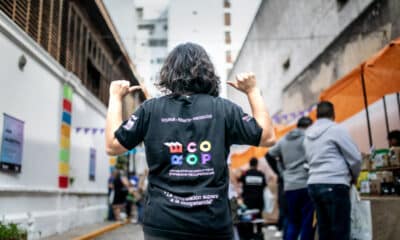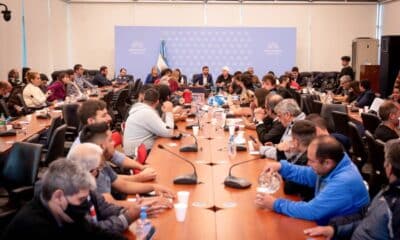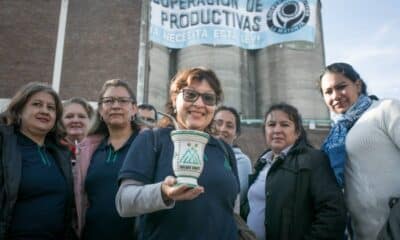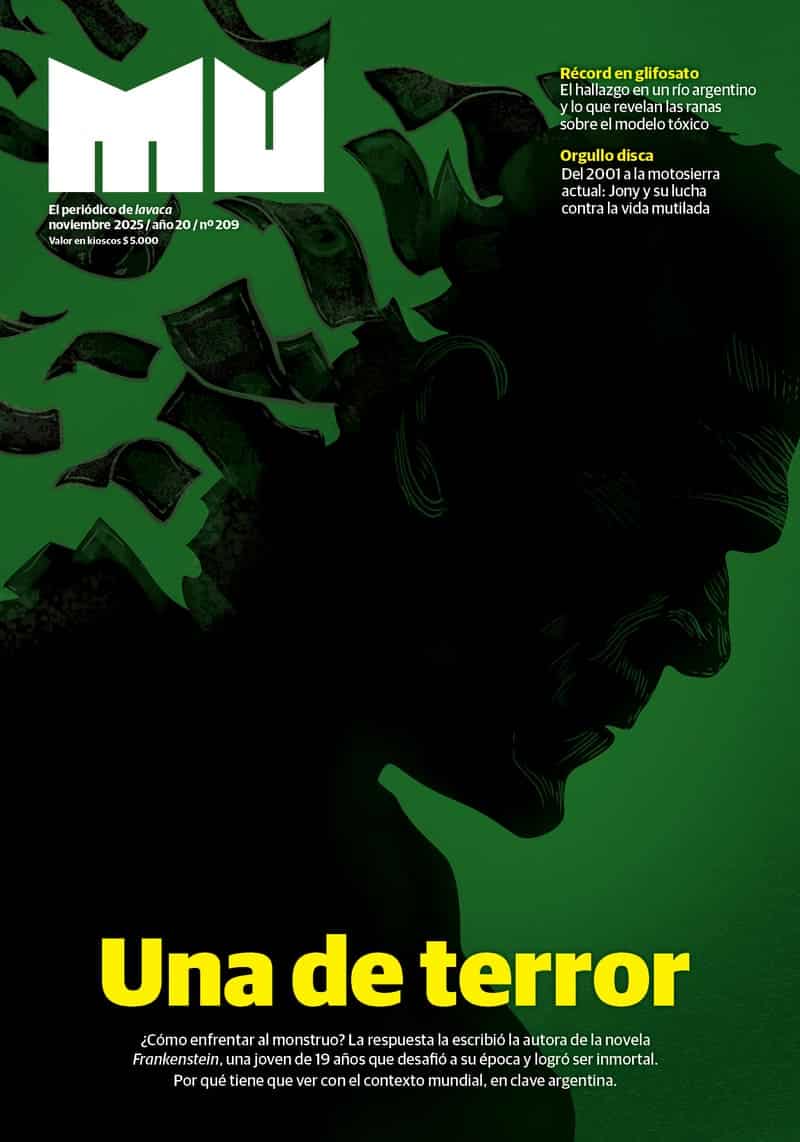CABA
Stories from Argentina’s worker-run factories
Preface, Avi Lewis and Naomi Klein
On March 19, 2003, we were on the roof of the Zanon ceramic tile factory, filming an interview with Cepillo. He was showing us how the workers fended off eviction by armed police, defending their democratic workplace with slingshots and the little ceramic balls normally used to pound the Patagonian clay into raw material for tiles. His aim was impressive. It was the day the bombs started falling on Baghdad.
As journalists, we had to ask ourselves what we were doing there. What possible relevance could there be in this one factory at the southernmost tip of our continent, with its band of radical workers and its David and Goliath narrative, when bunker-busting apocalypse was descending on Iraq?
But we, like so many others, had been drawn to Argentina to witness firsthand an explosion of activism in the wake of its 2001 crisis – a host of dynamic new social movements that were not only advancing a bitter critique of the economic model that had destroyed their country, but were busily building local alternatives in the rubble.
There were many popular responses to the crisis, from neighbourhood assemblies and barter clubs to resurgent leftwing parties and mass movements of the unemployed, but we spent most of our year in Argentina with workers in «recovered companies.» Almost entirely under the media radar, workers in Argentina have been responding to rampant unemployment and capital flight by taking over traditional businesses that have gone bankrupt and are reopening them under democratic, worker management. It’s an old idea reclaimed and retrofitted for a brutal new time. The principles are so simple, so elementally fair, that they seem more self-evident than radical when articulated by one of the workers in this book: «We formed the cooperative with the criteria of equal wages, making basic decisions by assembly; we are against the separation of manual and intellectual work, we want a rotation of positions and, above all, the ability to recall our elected leaders.»
The movement of recovered companies is not epic in scale – some 170 companies, around 10,000 workers in Argentina. But six years on, and unlike some of the country’s other new movements, it has survived and continues to build quiet strength in the midst of the country’s deeply unequal «recovery». Its tenacity is a function of its pragmatism: this is a movement that is based on action, not talk. And its defining action, re-awakening the means of production under worker control, while loaded with potent symbolism, is anything but symbolic. It is feeding families, rebuilding shattered pride, and opening a window of powerful possibility.
Like a number of other emerging social movements around the world, the workers in the recovered companies are re-writing the traditional script for how change is supposed to happen. Rather than following anyone’s 10-point plan for revolution, the workers are darting ahead of the theory – at least, straight to the part where they get their jobs back. In Argentina, the theorists are chasing after the factory workers, trying to analyze what is already in noisy production.
These struggles have had a tremendous impact on the imaginations of activists around the world – at this point there are many more starry-eyed grad papers on the phenomenon than there are recovered companies. But there is also a renewed interest in democratic workplaces from Durban to Melbourne to New Orleans.
That said, the movement in Argentina is as much as product of the globalization of alternatives as it is one of its most contagious stories. Argentine workers borrowed the slogan, «Occupy, Resist, Produce» from Latin America’s largest social movement, Brazil’s Movimiento Sin Terra, in which more than a million people have reclaimed unused land and put it back into community production. One worker told us that what the movement in Argentina is doing is «MST for the cities». In South Africa, we saw a protester’s t-shirt with an even more succinct summary of this new impatience: Stop Asking, Start Taking.
But as much as these similar sentiments are blossoming in different parts of the world for the same reasons, there is an urgent need to share these stories and tools of resistance even more widely. For that reason, this translation that you are holding is of tremendous importance: it’s the first comprehensive portrait of Argentina’s famous movement of recovered companies in English.
The book’s author is the Lavaca collective, itself a worker cooperative like the struggles documented here. While we were in Argentina filming our documentary, The Take, we ran into Lavaca members wherever the workers’ struggles led – the courts, the legislature, the streets, the factory floor. They do some of the most sophisticated engaged journalism in the world today.
And this book is classic Lavaca. That means it starts with a montage – a theoretical framework that is unabashedly poetic. Then it cuts to a fight scene of the hard facts: the names, the numbers, and the M.O. behind the armed robbery that was Argentina’s crisis. With the scene set, the book then zooms in to the stories of individual struggles, told almost entirely through the testimony of the workers themselves.
This approach is deeply respectful of the voices of the protagonists, while still leaving plenty of room for the authors’ observations, at once playful and scathing. In this interplay between the cooperatives that inhabit the book and the one that produced it, there are a number of themes that bear mention.
First of all, there is the question of ideology. This movement is frustrating to some on the left who feel it is not clearly anti-capitalist, those who chafe at how comfortably it exists within the market economy and see worker management as merely a new form of auto-exploitation. Others see the project of cooperativism, the legal form chosen by the vast majority of the recovered companies, as a capitulation in itself – insisting that only full nationalization by the state can bring worker democracy into a broader socialist project.
In the words of the workers, and in between the lines, you get a sense of these tensions and the complex relationship between various struggles and parties of the left in Argentina. Workers in the movement are generally suspicious of being coopted to anyone’s political agenda, but at the same time cannot afford to turn down any support. But more interesting by far is to see how workers in this movement are politicized by the struggle, which begins with the most basic imperative: workers want to work, to feed their families. You can see in this book how some of the most powerful new working class leaders in Argentina today discovered solidarity on a path that started from that essentially apolitical point.
But whether you think the movement’s lack of a leading ideology is a tragic weakness or a refreshing strength, this book makes clear precisely how the recovered companies challenge capitalism’s most cherished ideal: the sanctity of private property.
The legal and political case for worker control in Argentina does not only rest on the unpaid wages, evaporated benefits and emptied-out pension funds. The workers make a sophisticated case for their moral right to property – in this case, the machines and physical premises – based not just on what they’re owed personally, but what society is owed. The recovered companies propose themselves as an explicit remedy to all the corporate welfare, corruption, and other forms of public subsidy the owners enjoyed in the process of bankrupting their firms and moving their wealth to safety, abandoning whole communities to the twilight of economic exclusion.
This argument is, of course, available for immediate use in the United States.
But this story goes much deeper than corporate welfare. And that’s where the Argentine experience will really resonate with Americans. It’s become axiomatic on the left to say that Argentina’s crash was a direct result of the IMF orthodoxy imposed on the country with such enthusiasm in the neoliberal 1990s. What this book makes clear is that in Argentina, just as in the U.S. occupation of Iraq, those bromides about private sector efficiency were nothing more than a cover story for an explosion of frontier-style plunder – looting on a massive scale by a small group of elites. Privatization, deregulation, labor flexibility: these were the tools to facilitate a massive transfer of public wealth to private hands, not to mention private debts to the public purse. Like Enron traders, the businessmen who haunt the pages of this book learned the first lesson of capitalism and stopped there: greed is good, and more greed is better. As one worker says in the book, «There are guys that wake up in the morning thinking about how to screw people, and others who think, how do we rebuild this Argentina that they have torn apart?
And in the answer to that question, you can read a powerful story of transformation. This book takes as a key premise that capitalism produces and distributes not just goods and services, but identities. When the capital and its carpet baggers had flown, what was left was not only companies that had been emptied, but a whole hollowed-out country filled with people whose identities – as workers – had been stripped away too.
As one of the organizers in the movement wrote to us, «It is a huge amount of work to recover a company. But the real work is to recover a worker – and that is the task that we have just begun.»
On April 17, 2003, we were on Avenida Jujuy in Buenos Aires – standing with the Brukman workers and a huge crowd of their supporters in front of a fence, behind which was a small army of police guarding the Brukman factory. After a brutal eviction, the workers were determined to get back to work at their sewing machines.
In Washington DC that day, USAID announced that it had chosen Bechtel corporation as the prime contractor for the reconstruction of Iraq’s architecture. The heist was about to begin in earnest, both in the US and in Iraq. Deliberately-induced crisis was providing the cover for the transfer of billions of tax dollars to a handful of politically-connected corporations.
In Argentina, they’d already seen this movie – the wholesale plunder of public wealth, the explosion of unemployment, the shredding of the social fabric, the staggering human consequences. And 52 seamstresses were in the street, backed by thousands of others, trying to take back what was already theirs. It was definitely the place to be.
Avi Lewis and Naomi Klein
Derechos Humanos
A 40 años de la sentencia: ¿Qué significa hoy el Juicio a las Juntas?
Este martes 9 de diciembre se cumplen 40 años de la lectura de la sentencia del Juicio a las Juntas Militares. Habrá un acto en la Corte Suprema de homenaje a los jueces Carlos Arslanián, Ricardo Gil Lavedra, Guillermo Ledesma y Jorge Valerga Aráoz (fallecieron los otros dos integrantes de aquella Cámara Federal: Andrés D’Alessio y Jorge Torlasco).
Testigo privilegiado de muchas de las audiencias por su cobertura para el diario La Razón, Sergio Ciancaglini, actual periodista de MU y coautor del libro Nada más que la verdad (junto a Martín Granovsky) repasa escenas, revelaciones y el contexto de una experiencia inédita en el mundo en la que por primera vez se juzgó un crimen masivo cometido desde el Estado por una dictadura.
Los testigos, los alegatos, las sorpresas, la ubicación de la locura y de la cordura. Los gestos de Videla, Massera y Viola. Los testimonios de las mujeres sobre los ataques y violaciones que sufrieron. El antisemitismo militar. El peso desde el cual los médicos calculaban que era factible torturar. El sitio de lo impensable, y la proyección de aquella historia pensando en los derechos humanos del presente.
Por Sergio Ciancaglini
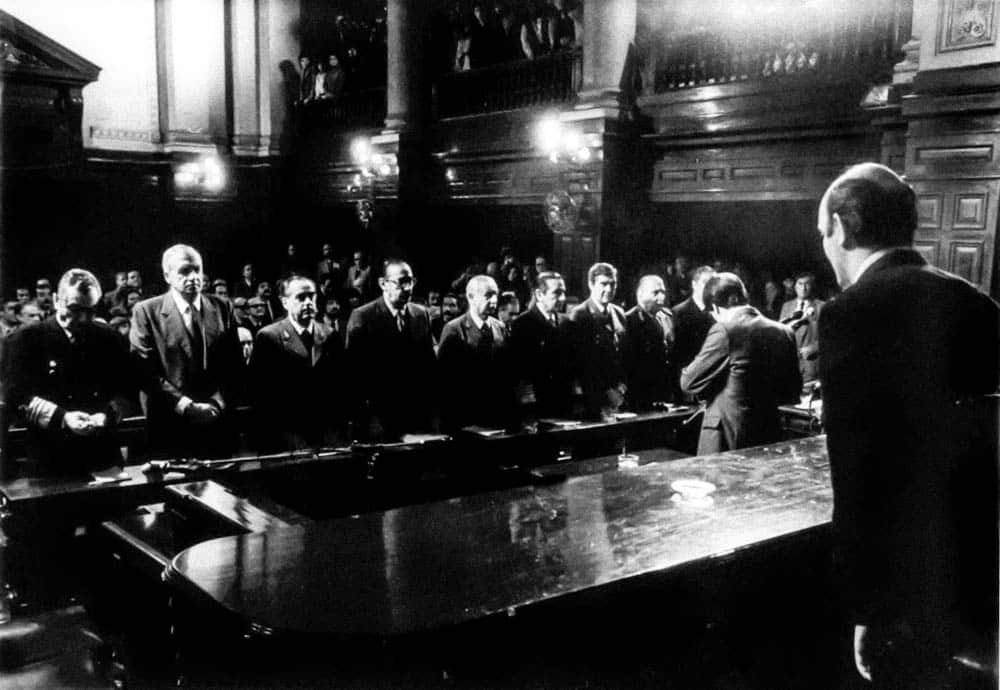
Portada
Sin pan y a puro circo: la represión a jubilados para tapar otra derrota en el Congreso
La marcha pacífica de jubilados y jubiladas volvió a ser reprimida por la Policía de la Ciudad para impedir que llegara hasta la avenida Corrientes. La Comisión Provincial por la Memoria confirmó cuatro detenciones (entre ellas, un jubilado) que la justicia convalidó y cuatro personas heridas. Una fue una jubilada a quien los propios manifestantes […]

La marcha pacífica de jubilados y jubiladas volvió a ser reprimida por la Policía de la Ciudad para impedir que llegara hasta la avenida Corrientes. La Comisión Provincial por la Memoria confirmó cuatro detenciones (entre ellas, un jubilado) que la justicia convalidó y cuatro personas heridas. Una fue una jubilada a quien los propios manifestantes salvaron de que los uniformados la pasaran por arriba. En medio del narcogate de Espert, quien pidió licencia en Diputados por “motivos personales”, las imágenes volvieron a exhibir la debilidad del Gobierno, golpeando a personas con la mínima que no llegan a fin de mes, mientras sufría otra derrota en la Cámara baja, que aprobó con 140 votos afirmativos la ley que limita el uso de los DNU por parte de Milei.
Por Francisco Pandolfi y Lucas Pedulla.
Fotos: Juan Valeiro.
Un jubilado de setenta y tantos eleva un cartel bien alto con sus dos manos.
“Pan y circo”, dice.
Pero el “pan” y la “y” están tachados, porque en este miércoles, como en esta época, lo que falta de pan sobra de circo. El triste espectáculo lo ofrece una vez más la policía, hoy particularmente la de la Ciudad, que desplegó un cordón sobre Callao, casi a la altura de Sarmiento, para evitar que la pacífica movilización de jubilados y jubiladas llegara hasta la avenida Corrientes. Detrás de los escudos, aparecieron los runrunes de la motorizada para atemorizar. Y envalentonados, los escudos avanzaron contra todo lo que se moviera, con una estrategia perversa: cada tanto, los policías abrían el cordón y de atrás salían otros uniformados que, al estilo piraña, cazaban a la persona que tenían enfrente. Algunos zafaron a último milímetro.
Pero los oficiales detuvieron a cuatro: el jubilado Víctor Amarilla, el fotógrafo Fabricio Fisher, un joven llamado Cristian Zacarías Valderrama Godoy, y otro hombre llamado Osvaldo Mancilla.
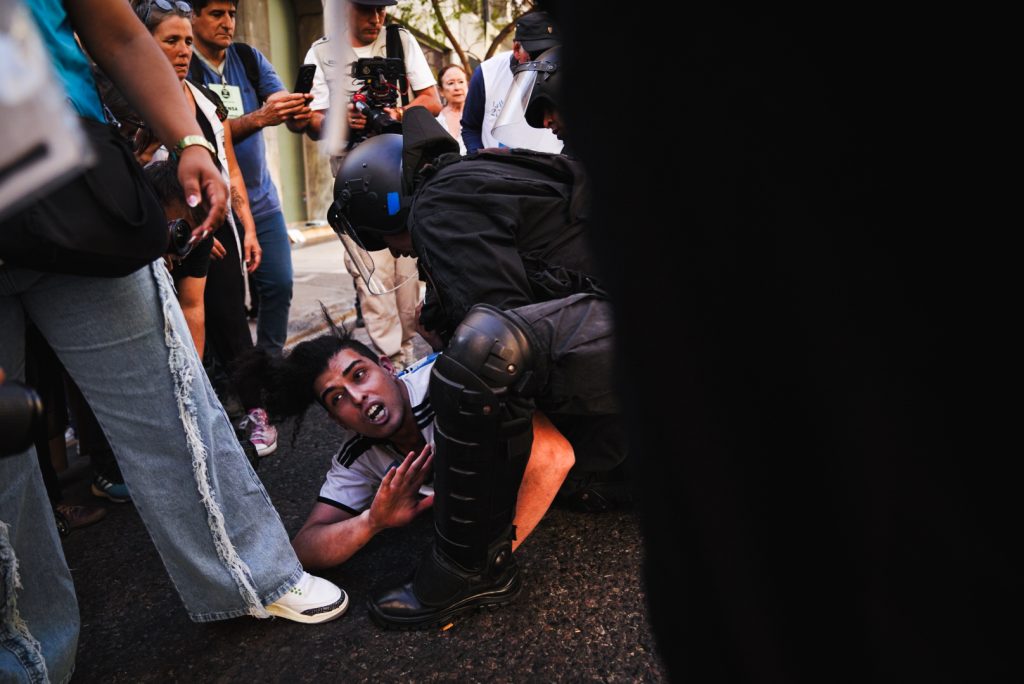
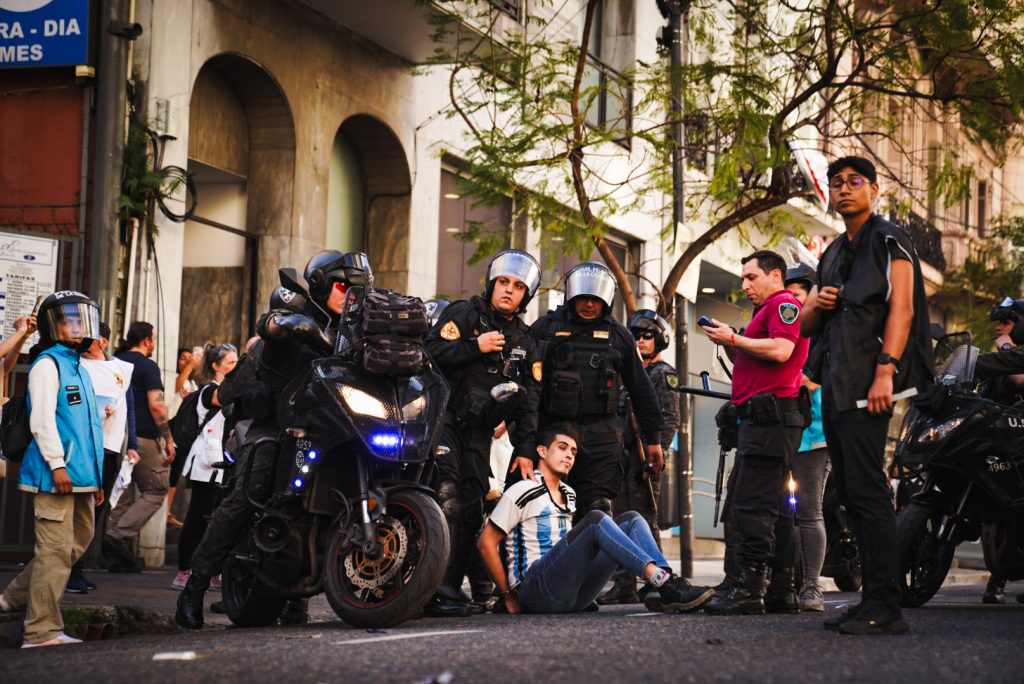

Las detenciones de Cristian Zacarías y del fotógrafo Fabricio Fisher. La policía detuvo al periodista mientras estaba de espaldas. Foto: Juan Valeiro para lavaca.org
En esa avanzada, una jubilada llamada María Rosa Ojeda cayó al suelo por los golpes y fue la rápida intervención de los manifestantes, del Cuerpo de Evacuación y Primeros Auxilios (CEPA), y de otros rescatistas los que la ayudaron. “Gracias a todos ellos la policía no me pasó por encima”, dijo. Su única arma era un bastón con la bandera de argentina.
Como en otros miércoles de represión, la estrategia pareciera buscar que estas imágenes opaquen aquellas otras que evidencian el momento de debilidad que atraviesa el Gobierno. Hoy no sólo el diputado José Luis Espert, acusado de recibir dinero de Federico «Fred» Machado, empresario extraditado a Estados Unidos por una causa narco, se tomó licencia alegando “motivos personales”, sino que la Cámara baja sancionó, por 140 votos a favor, 80 negativos y 17 abstenciones, la ley que limita el uso de los Decretos de Necesidad y Urgencia (DNU) por parte del Presidente. El gobierno anunció un clásico ya de esta gestión: el veto.
Por ahora, el proyecto avanza hacia el Senado.
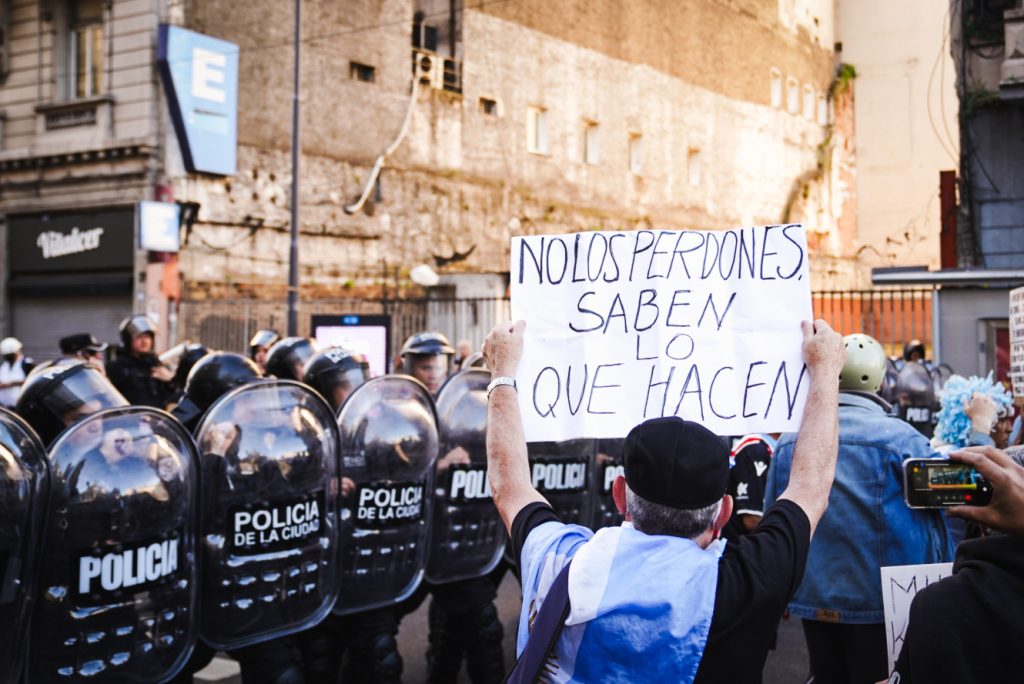
Foto: Juan Valeiro para lavaca.org
El poco pan
La calle preveía este golpe, y por eso durante este miércoles se cantó:
“Si no hay aumento,
consiganló,
del 3%
que Karina se robó”.
Ese tema fue el hit del inicio de la jornada de este miércoles, aunque hilando fino carece de verdad absoluta, porque las jubilaciones de octubre sí registraron un aumento: el 1,88%, que llevó el haber mínimo a $326.298,38. Sumado al bono de 70 mil, la mínima trepó a $396 mil. “Es un valor irrisorio. Seguimos sumergidos en una vida que no es justa y el gobierno no afloja un mango, es tremendo cómo vivimos”, cuenta Mario, que no hay miércoles donde no diga presente. “Nos hipotecan el presente y el futuro también, cerrando acuerdos con el FMI que nos impone cómo vivir, y no es más que pan para hoy y hambre para mañana, aunque el pan para hoy te lo debo”.
Victoria tiene 64 años y es del barrio porteño de Villa Urquiza. Cuenta que desde hace 10 meses no puede pagar las expensas. Y que por eso el consorcio le inició un juicio. Cuenta que otra vecina, de 80, está en la misma. Cuenta que es insulina dependiente pero que ya no la compra porque no tiene con qué. Cuenta que su edificio es 100% eléctrico y que de luz le vienen alrededor de 140 mil pesos, más de un tercio de su jubilación. Cuenta que está comiendo una vez por día y que su “dieta” es “mate, mate y mate”. Vuelve a sonreír cuando cuenta que tiene 3 hijos y 4 nietos y cuando dice que va a resistir: “Hasta cuando pueda”.
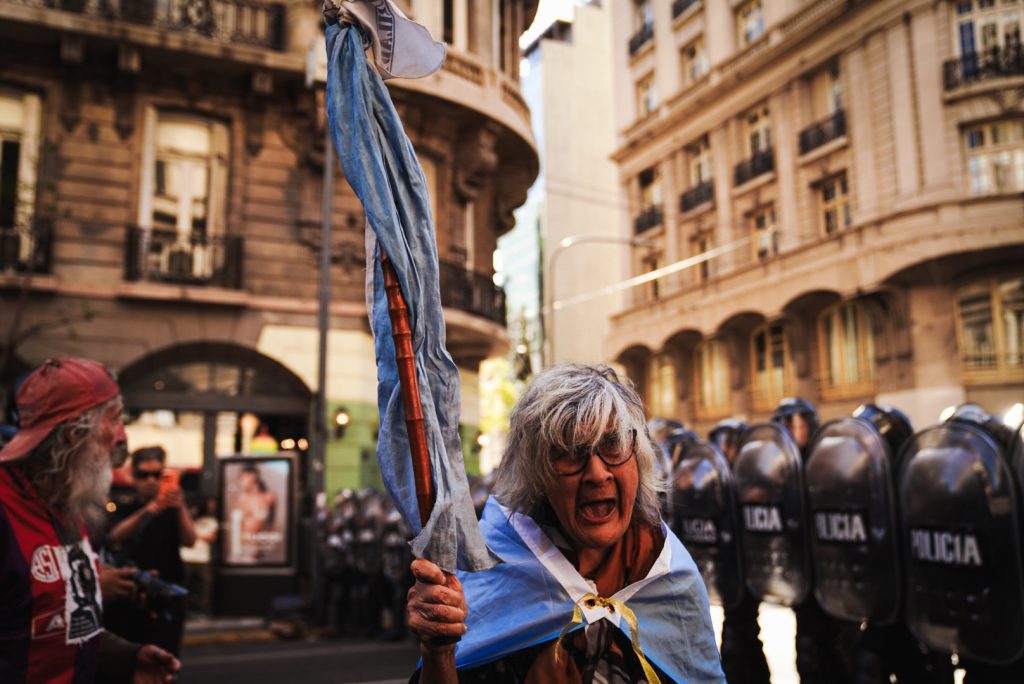
A María Rosa la salvó la gente de que la policía la pasara por arriba. Foto: Juan Valeiro para lavaca.org
El mucho circo
Desde temprano hubo señales de que la represión policial estaba al caer. A diferencia de los miércoles anteriores, la Policía no cortó la avenida Rivadavia a la altura de Callao. Tampoco cortó el tránsito, lo que permitió que los jubilados y las jubiladas cortaran la calle para hacer semaforazos. Después de media hora, cuando la policía empezó a desviar el tránsito y la calle quedó desolada, comenzó la marcha, pero en vez de rodear la Plaza de los Dos Congresos como es habitual, caminó por Callao en dirección a Corrientes, hasta metros de la calle Sarmiento, donde se erigió un cordón policial y empezó a avanzar contra las y los manifestantes.
Desde atrás, irrumpieron con violencia dos cuerpos en moto: el GAM (Grupo de Acción Motorizada) y el USyD (Unidad de Saturación y Detención), pegando con bastones e insultando a quienes estaban en la calle. “Vinieron a pegarme directamente, mi pareja me quiso ayudar y lo detuvieron a él, que no estaba haciendo nada”, cuenta Lucas, el compañero de Cristian Zacarías, uno de los detenidos.
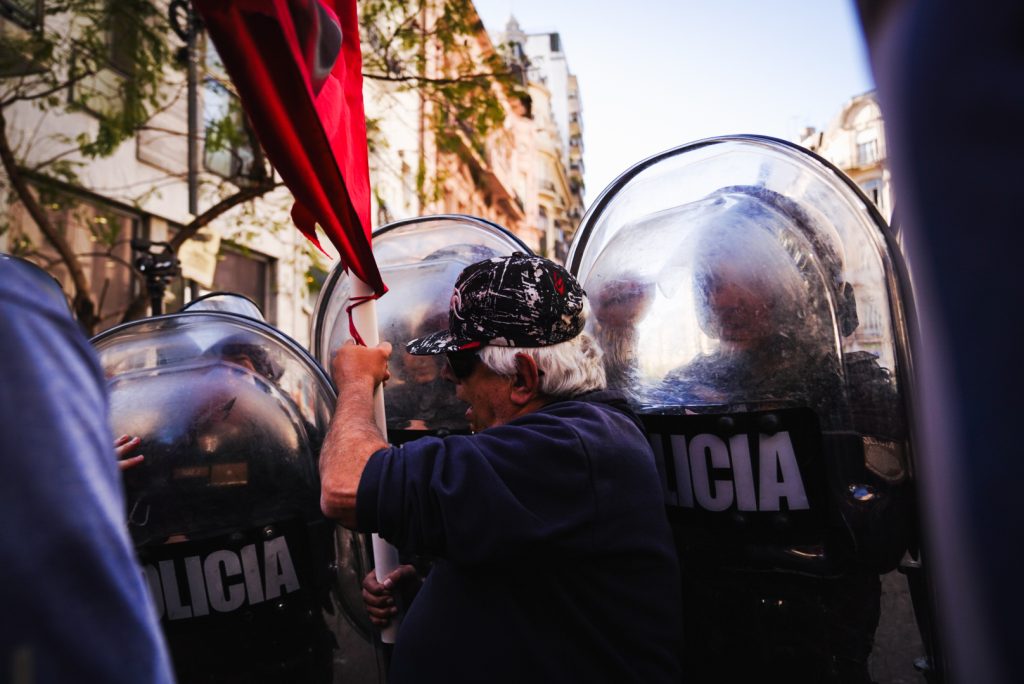
Foto: Juan Valeiro para lavaca.org
Cercaron el lugar una centena de efectivos de la policía porteña, que no permitieron a la prensa acercarse ni estar en la vereda registrando la escena.
“¿Alguien me puede decir si la detención fue convalidada”, pregunta Lucas al pelotón policial.
Silencio.
“¿Me pueden decir sí o no?”.
Silencio.
Un comerciante mira y vocifera: “¿Sabés lo que hicieron a la vuelta? Subieron a la vereda con las motos”.
Otro se acerca y pregunta: “¿A quién tienen detenido acá, al Chapo Guzmán?”
“No”, le responde seco un periodista: “A un pibe y a un jubilado”.
La Comisión Provincial por la Memoria confirmó las cuatro detenciones (fue aprehendida una quinta persona y derivada al SAME para su atención) y cuatro personas heridas. El despliegue incluyó la presencia también de Policía Federal, Prefectura y Gendarmería detrás del Congreso mientras el despliegue represivo fue «comandado por agentes de infantería de la Policía de la Ciudad». El organismo observó que después de semanas donde el operativo disponía el vallado completo, en los últimos miércoles el dispositivo dejó abierta una vía de circulación que es la que eligen las fuerzas para avanzar contra los manifestantes.
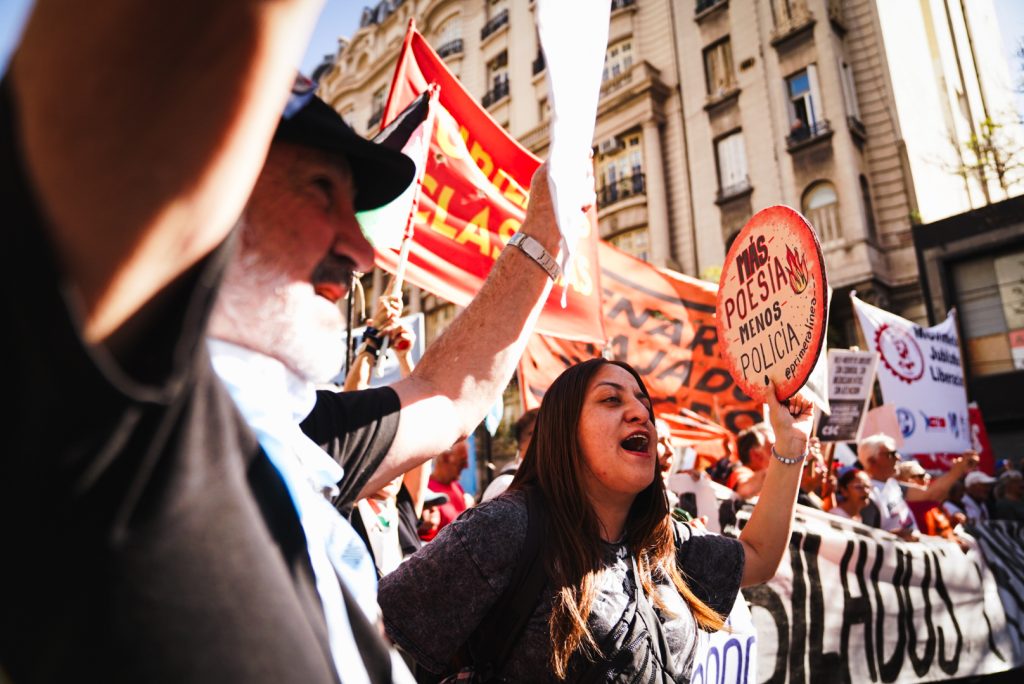
Foto: Juan Valeiro para lavaca.org
También se hizo presente Fabián Grillo, papá de Pablo, que sufrió esa represión el 12 de marzo, en esta misma plaza, y continúa su rehabilitación en el Hospital Rocca. “Su evolución es positiva”, comunicó la familia. El fotorreportero está empezando a comer papilla con ayuda, continúa con sonda como alimento principal, se sienta y se levanta con asistencia y le están administrando medicación para que esté más reactivo. “Seguimos para adelante, lento, pero a paso firme”, dicen familiares y amigos. El martes, la jueza María Servini procesó al gendarme Héctor Guerrero por el disparo. El domingo se cumplirán siete meses y lo recordarán con un festival.
Pablo Caballero mira toda esta disposición surrealista desde un costado. Tiene 76 años y cuatro carteles pegados sobre un cuadrado de cartón tan grande que va desde el piso del Congreso hasta su cintura:
- “Roba, endeuda, estafa, paga y cobra coimas. CoiMEA y nos dice MEAdos. Miente, se contradice, vocifera, insulta, violenta, empobrece, fuga, concentra. ¿Para qué lo queremos? No queremos, ¡basta! Votemos otra cosa”.
- “El 3% de la coimeada más el 7% del chorro generan 450% de sobreprecios de medicamentos”.
- El tercer cartel enumera todo lo que “mata” la desfinanciación: ARSAT, INAI, CAREM, CONICET, ENERC, Gaumont, INCAA, Banco Nación, Aerolíneas, Hidrovía, agua, gas, litio, tierras raras, petróleo, educación. Una enumeración del saqueo.
El cuarto cartel lo explica Pablo: “Cobro la jubilación mínima, que equivale al 4% de lo que cobran los que deciden lo que tenemos que cobrar, que son 10 millones de pesos. No tiene sentido. Por eso, hay que ir a votar en octubre”.
Pablo mira al cielo, como una imploración: «¡Y que se vayan!».

Foto: Juan Valeiro para lavaca.org

Foto: Juan Valeiro para lavaca.org
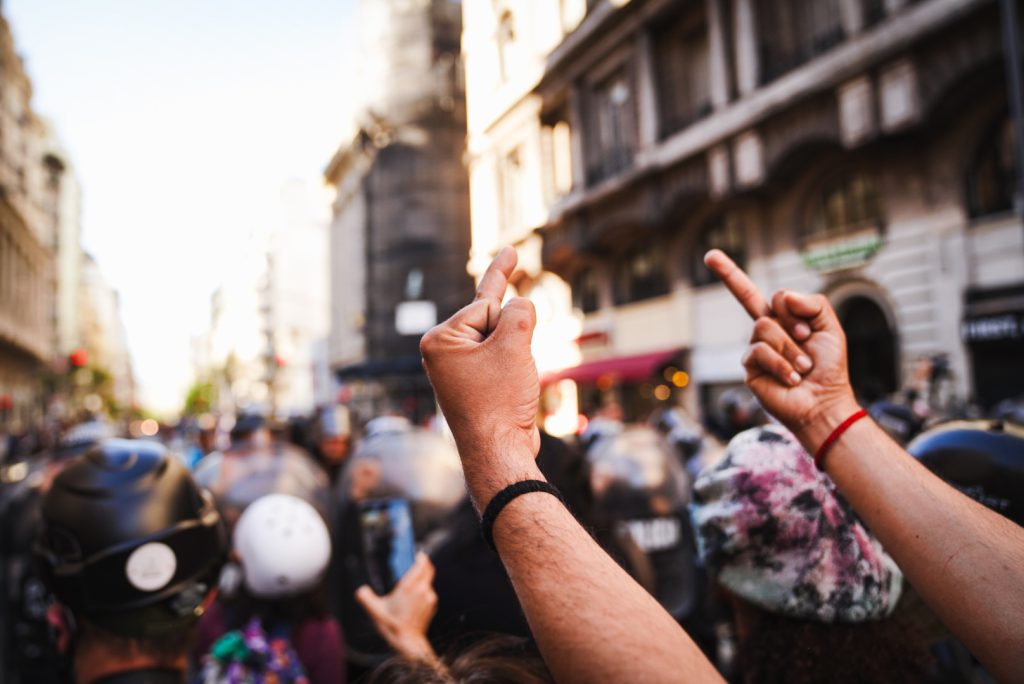
Foto: Juan Valeiro para lavaca.org
Artes
Un festival para celebrar el freno al vaciamiento del teatro

La revista Llegás lanza la 8ª edición de su tradicional encuentro artístico, que incluye 35 obras a mitad de precio y algunas gratuitas. Del 31 de agosto al 12 de septiembre habrá espectáculos de teatro, danza, circo, música y magia en 15 salas de la Ciudad de Buenos Aires. El festival llega con una victoria bajo el brazo: este jueves el Senado rechazó el decreto 345/25 que pretendía desguazar el Instituto Nacional del Teatro.
Por María del Carmen Varela.
«La lucha continúa», vitorearon este jueves desde la escena teatral, una vez derogado el decreto 345/25 impulsado por el gobierno nacional para vaciar el Instituto Nacional del Teatro (INT).
En ese plan colectivo de continuar la resistencia, la revista Llegás, que ya lleva más de dos décadas visibilizando e impulsando la escena local, organiza la 8ª edición de su Festival de teatro, que en esta ocasión tendrá 35 obras a mitad de precio y algunas gratuitas, en 15 salas de la Ciudad de Buenos Aires. Del 31 de agosto al 12 de septiembre, más de 250 artistas escénicos se encontrarán con el público para compartir espectáculos de teatro, danza, circo, música y magia.
El encuentro de apertura se llevará a cabo en Factoría Club Social el domingo 31 de agosto a las 18. Una hora antes arrancarán las primeras dos obras que inauguran el festival: Evitácora, con dramaturgia de Ana Alvarado, la interpretación de Carolina Tejeda y Leonardo Volpedo y la dirección de Caro Ruy y Javier Swedsky, así como Las Cautivas, en el Teatro Metropolitan, de Mariano Tenconi Blanco, con Lorena Vega y Laura Paredes. La fiesta de cierre será en el Circuito Cultural JJ el viernes 12 de septiembre a las 20. En esta oportunidad se convocó a elencos y salas de teatro independiente, oficial y comercial.
Esta comunión artística impulsada por Llegás se da en un contexto de preocupación por el avance del gobierno nacional contra todo el ámbito de la cultura. La derogación del decreto 345/25 es un bálsamo para la escena teatral, porque sin el funcionamiento natural del INT corren serio riesgo la permanencia de muchas salas de teatro independiente en todo el país. Luego de su tratamiento en Diputados, el Senado rechazó el decreto por amplia mayoría: 57 rechazos, 13 votos afirmativos y una abstención.
“Realizar un festival es continuar con el aporte a la producción de eventos culturales desde diversos puntos de vista, ya que todos los hacedores de Llegás pertenecemos a diferentes disciplinas artísticas. A lo largo de nuestros 21 años mantenemos la gratuidad de nuestro medio de comunicación, una señal de identidad del festival que mantiene el espíritu de nuestra revista y fomenta el intercambio con las compañías teatrales”, cuenta Ricardo Tamburrano, director de la revista y quien junto a la bailarina y coreógrafa Melina Seldes organizan Llegás.
Más información y compra de entradas: www.festival-llegas.com.ar

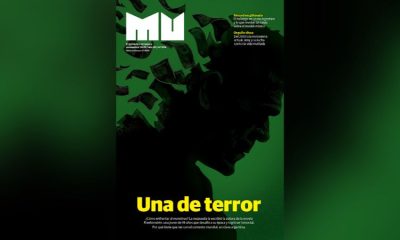
 Revista MuHace 3 semanas
Revista MuHace 3 semanasMu 209: Una de terror
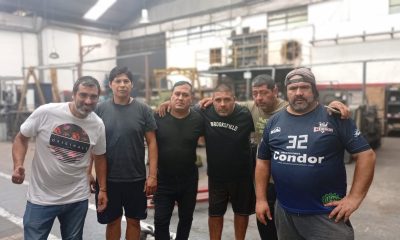
 ActualidadHace 3 días
ActualidadHace 3 díasItuzaingó: los trabajadores ocupan la fábrica de ascensores Cóndor y proyectan una cooperativa

 Derechos HumanosHace 2 semanas
Derechos HumanosHace 2 semanasA 40 años de la sentencia: ¿Qué significa hoy el Juicio a las Juntas?
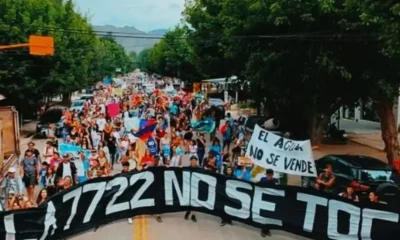
 ActualidadHace 3 semanas
ActualidadHace 3 semanasExtractivismo en Mendoza: movilización y rechazo ante la legislatura por el intento de votación del proyecto San Jorge

 ActualidadHace 2 semanas
ActualidadHace 2 semanasMendoza en caravana hacia la capital provincial contra el proyecto minero San Jorge






